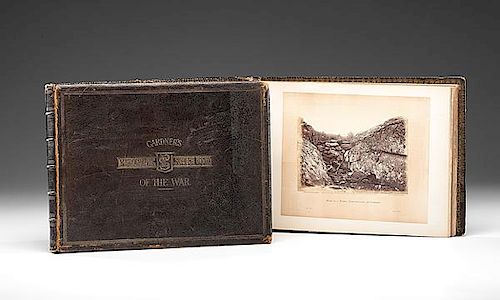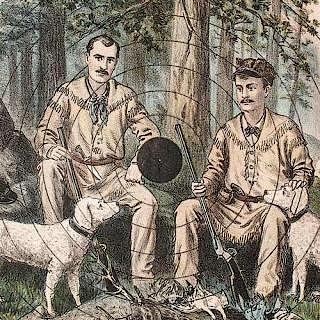Gardner's Photographic Sketch Book of the War, Philp & Solomons, 1865-1866
About Seller
6270 Este Ave.
Cincinnati , OH 45232
United States
With offices in Cincinnati, Cleveland and Denver, Cowan’s holds over 40 auctions each year, with annual sales exceeding $16M. We reach buyers around the globe, and take pride in our reputation for integrity, customer service and great results. A full-service house, Cowan’s Auctions specializes in Am...Read more
Two ways to bid:
- Leave a max absentee bid and the platform will bid on your behalf up to your maximum bid during the live auction.
- Bid live during the auction and your bids will be submitted real-time to the auctioneer.
Bid Increments
| Price | Bid Increment |
|---|---|
| $0 | $25 |
| $500 | $50 |
| $1,000 | $100 |
| $2,000 | $250 |
| $5,000 | $500 |
| $10,000 | $1,000 |
| $20,000 | $2,500 |
| $50,000 | $5,000 |
| $100,000 | $10,000 |
About Auction
Nov 20, 2015 - Nov 21, 2015
Cowan's Auctions dawnie@cowans.com
- Lot Description
Gardner's Photographic Sketch Book of the War, Philp & Solomons, 1865-1866
Two volumes, oblong folio. Washington: Philp and Solomons, 1865-66. With pictorial title pages after A.R. Ward, containing 100 albumen photographs by Gardner and others, each 6.75 x 8.75 in., mounted on larger sheets with pre-printed mounting blocks and printed captions. Each plate accompanied by a printed page describing the image. Published pebbled dark brown/black morocco, with gilt-decorative borders and the publisher's gilt monogram, all edges gilt. First edition.
Called the "first modern photo-essay" (Stapp 1991: 28), Gardner's "sketch book" is recognized as the first published collection of Civil War photographs. Conceived by Gardner as a post-war memento, the 100 photographs represent selections from the over 3,000 negatives taken during the Civil War by himself and associates. Unlike Brady, Gardner carefully credits each of the original photographers who took the negative: George Barnard, Timothy O'Sullivan, William R. Pywell, W. Morris Smith, David Knox, and D.B. Woodbury. As Stapp notes, Gardner viewed the text and photographs to function as an extended essay comprising images and explanatory text that worked together organically (ibid: 28). The Sketch Book is organized chronologically, and covers the war in Virginia, Maryland, and Pennsylvania, with the central event the battle of Gettysburg.
Seminal photographs from this conflict include A Harvest of Death; Field Where General Reynolds Fell; Home of the Rebel Sharpshooter; and Sharpshooter's Last Sleep. Exhibited in New York shortly after the battle, these images dramatically brought home the carnage of the battle, and shocked American's who previously had an abstract view of the War.
It has been estimated that no more than 200 copies of the Sketch Book were produced. This example includes the following dated, personalized presentation in ink on the front flyleaf: Anne P [?] Howard. From her Husband. Dec. 31st, 1866. Copies of the Sketch Book with a period presentation are rarely encountered.Volume I: Scuffing to the corners, head and foot of spine. Scattered surface abrasions on covers. Free front end paper completely separated from spine. Crease in front fly leaf (bearing period inscription), with tape affixed along top edge where there is a short vertical tear. Light stain along top edge of front fly leaf and title page. Free rear end paper partially separated from spine. Light handling wear to pages throughout. Plates 18 through 21 (and accompanying descriptive pages) fully separated from spine.Condition
Volume II: Heavier scuffing to the corners, head and foot of spine (compared with Volume I). Scattered surface abrasions on covers. Front cover partially separated from binding along bottom. Free front end paper completely separated from spine. Light handling wear to pages throughout. - Shipping Info
-
SHIPPING. At the request of the buyer, Cowan's will authorize the shipment of purchased items. Shipments usually occur within two weeks after payment has been received. Shipment is generally made via UPS Ground service. Unless buyer gives special instructions, the shipping method shall be at the sole discretion of Cowan's Auctions, Inc.. Cowan's is in no way responsible for the acts or omissions of independent handlers, packers or shippers of purchased items or for any loss, damage or delay from the packing or shipping of any property.
-
- Buyer's Premium



 EUR
EUR CAD
CAD AUD
AUD GBP
GBP MXN
MXN HKD
HKD CNY
CNY MYR
MYR SEK
SEK SGD
SGD CHF
CHF THB
THB


















